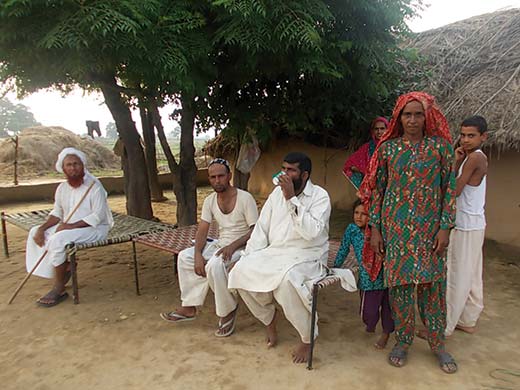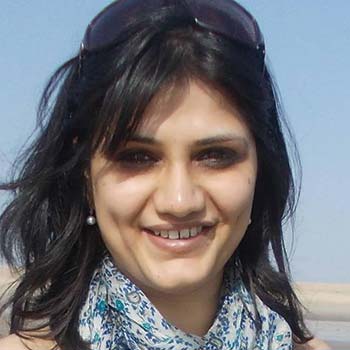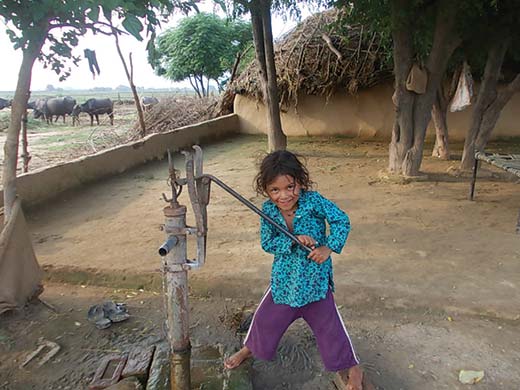Caught in the crossfire between India and Pakistan the people of J&K living near IB and LoC are on a razor’s edge. Meha Dixit spends a week in the frontier region to tell their stories of pain and loss


Ruksana tries to hide behind Kola Bibi, her face illuminated by the sunlight intensifies her smile, yet her eyes mirror certain fear of the uncertainty and insecurity, perhaps due to alleged firing and shelling from across the border that plague her village Jowrafarm. Ruksana, who is merely five years old, now looks at me curiously, her hesitant laughter livening the sleepy rustic landscape dominated by fawn huts and cattle that sluggishly moves across the fields. The sun dips below the low clouds, its crimson rays slowly dissolving into teal skies. Ruksana then whisks towards the hand pump by the ember-coloured trees. She is almost a silhouette now.
Jowrafarm is a village in Suchetgarh Sector, RS Pura, Jammu along the International Border (IB) between India and Pakistan. There are around 150 Gujjar families that live in this border village. Gujjars are basically nomadic people, however, in Jowrafarm these families have been settled for around 40 years. The main occupation of the people in the village is cattle rearing. The recent escalation of border tensions between India and Pakistan poses a huge threat to the physical, psychological and economic security of the people residing in this village. The village had witnessed firing and shelling just few days before I visited it on 10th and 11th August. Vijay Bhardwaj, a local journalist who accompanied me to the village informed that again intense firing and shelling took place on 18th July from 10 pm which continued till early next morning. However, fortunately there were no casualties and injuries.
Recently at Ufa in Russia, on the sidelines of the Shanghai Cooperation Organisation Summit, India and Pakistan issued a joint statement in which they “condemned terrorism in all its forms and agreed to cooperate with each other to eliminate the menace of terrorism from South Asia.”
Among other steps to be taken by both the countries, the joint statement included dialogue between the armies of India and Pakistan and a meeting between top security advisers to discuss terrorism. The Prime Minister of India also accepted an invitation by Prime Minister of Pakistan to the South Asian regional summit to be held in 2016 in Islamabad.
Notwithstanding the joint statement, tensions flared up between India and Pakistan armies on July 16, as both the countries made competing claims of 2003 ceasefire violations by security forces along the IB and the Line of Control (LoC).
Due to the recent tensions along the IB and the LoC between India and Pakistan, the civilian population or the border people have been hit hard on both sides. The escalation of violence has rendered a large number of civilians from the border villages homeless. As Kola Bibi from Jowrafarm wisecracks cheerfully, she also poignantly adds, “Sometimes for one or two months we are away from our home. There is no bunker in the village”.
Underground bunkers can be used by the border people for temporary shelter during the firing and shelling in the villages.
A few months back, the Jammu and Kashmir government submitted a proposal to the Union government for setting up over 20, 000 bunkers in the villages located close to the IB near Jammu and the LoC in Kashmir. Despite this, a number of villages along the border lack adequate bunkers. Kola Bibi further laments, “The government had promised to provide land to us in the safer areas, yet no one has received it in the village”. Most people in Jowrafarm are engaged in cattle rearing and unlike a number of border villages along the IB and LoC where the inhabitants depend mainly on agriculture and are only demanding makeshift shelter in safer areas, the former are willing to shift permanently to safer areas.
The uncertainty of border tensions between the two estranged neighbours poses a constant threat to the lives, property and livelihood of the civilians residing in the border villages on both sides. As a result, the civilians in these areas are likely to be affected physically, economically and psychologically. The physical impact of the border tensions is evident in the loss of lives or the injuries caused to the civilian population due to indiscriminate firing by both the Indian and Pakistani forces.

Yaseen from Jowrafarm was hit by a bullet last October but he survived, yet the impact of the firing was not just limited to physical injury and he continues to experience psychological trauma as well. Besides, the firing and shelling often lead to destruction of farms and cause injury or death of the livestock. Due to border tensions, the people often have to leave their homes and reside in the safer areas and are unable to get to work which affects their livelihood.
The constant physical and economic threat posed by the border skirmishes is likely to result in increased anxiety and stress among the civilians which may develop into serious psychological disorders. The civilians in the border areas are often compelled to live away from their homes even for months. This has enormous economic and psychosocial repercussions on their lives. Another critical issue is that of compensation for the families who have lost a family member or for those who have been injured during the firing and shelling. The state rarely provides them with adequate compensation. Yaseen from Jowrafarm who was injured by the bullet last year received merely Rs 5000 by the state government. The villagers say that he himself ended up spending around Rs 3 lakh for his treatment. Last October, another local from the village lost 15-20 cattle but he has not received any compensation so far.
In addition, the children residing in the border areas are affected tremendously. Internal displacement leads to disruption of education. Children may even have to spend months without schooling since they, along with their families, move to ‘safer’ areas during the border tensions; and may return to their homes only when the tensions subside. Due to incessant fear and uncertainty of their lives, children, in particular, are even more vulnerable to psychological trauma. Children and other people in the border villages along the IB and LoC incessantly live through invariable fear of the instability and uncertainty of the dreaded firing and shelling from across the border. Ruksana’s haunting eyes, which reflect an unvarying fear of the unsolicited din of the firing and shelling, embody the lives of the border people.















